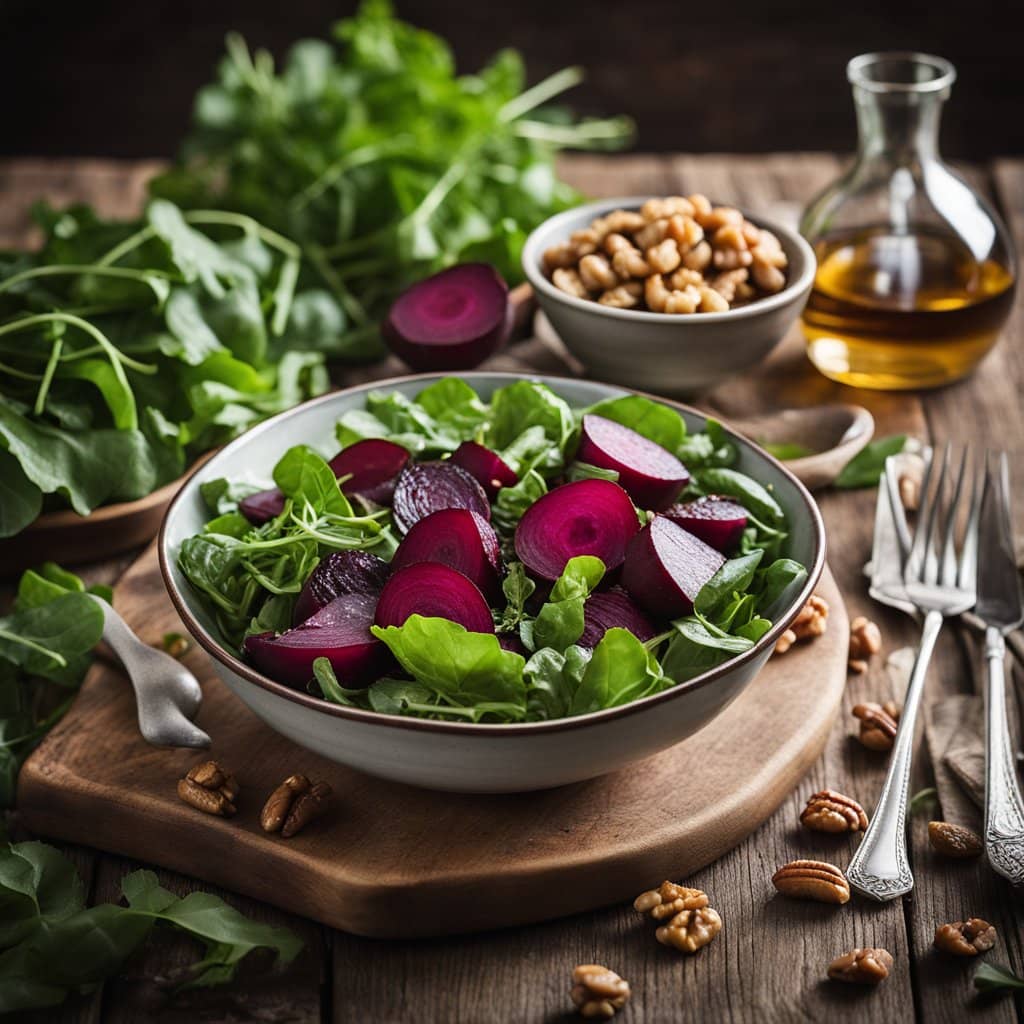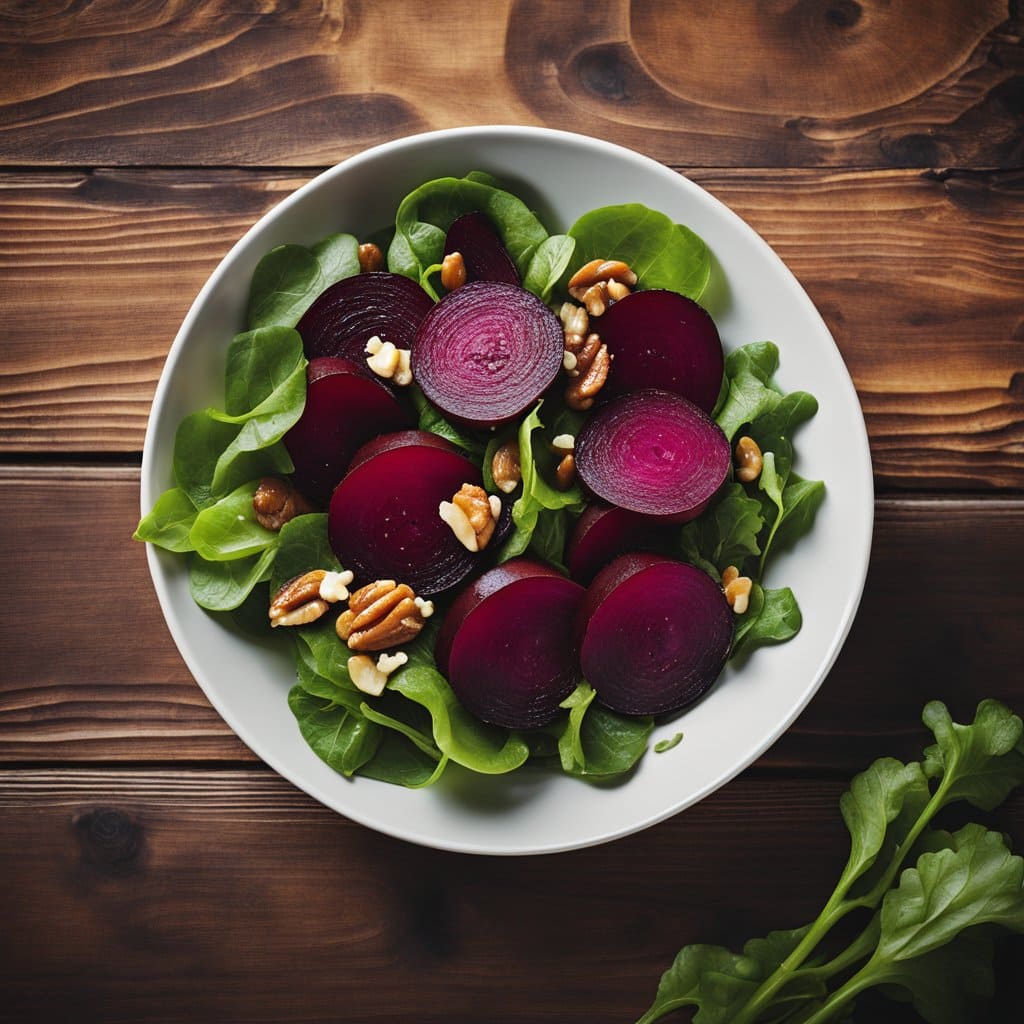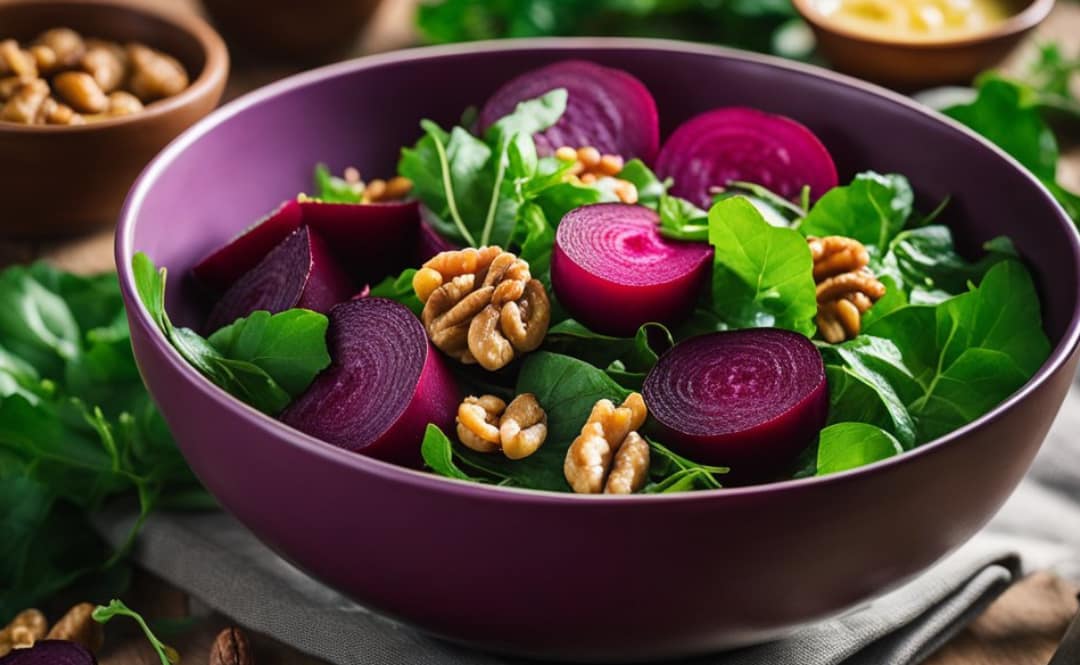Roasted beet and walnut salad is a delicious and healthy dish that is easy to prepare and packed with nutritional benefits. Beets are a rich source of vitamins, minerals, fiber, and antioxidants, while walnuts are loaded with healthy fats, protein, and essential nutrients. When combined in a salad, these two ingredients create a powerhouse of nutrition that can help boost your overall health and wellbeing.

One of the key benefits of roasted beet and walnut salad is its impressive nutritional profile. Beets are low in calories yet high in valuable vitamins and minerals, including vitamin C, folate, and potassium. They also contain nitrates, which have been shown to help lower blood pressure and improve exercise performance. Walnuts, on the other hand, are rich in omega-3 fatty acids, which are essential for brain health, heart health, and reducing inflammation in the body.
To prepare roasted beet and walnut salad, start by roasting the beets in the oven until they are tender and caramelized. Then, chop them into bite-sized pieces and toss them with a handful of chopped walnuts, a drizzle of olive oil, and a sprinkle of salt and pepper. You can also add other ingredients to the salad, such as goat cheese, arugula, or balsamic vinegar, to create different flavor profiles. Serve the salad as a side dish or a main course, depending on your appetite.
Key Takeaways
- Roasted beet and walnut salad is a nutritious and flavorful dish that can help boost your overall health and wellbeing.
- Beets are a rich source of vitamins, minerals, fiber, and antioxidants, while walnuts are loaded with healthy fats, protein, and essential nutrients.
- To prepare roasted beet and walnut salad, roast the beets in the oven, chop them into bite-sized pieces, and toss them with walnuts, olive oil, salt, and pepper.
Overview
Nutritional Profile and Health Benefits

Roasted beet and walnut salad is not only delicious but also packed with essential nutrients that provide numerous health benefits. Let’s take a closer look at the key vitamins and minerals in beets and walnuts and how they contribute to our health.
Key Vitamins and Minerals in Beets and Walnuts
Beets are low in calories but high in fiber, potassium, folate, vitamin C, magnesium, iron, and vitamin B6. They also contain antioxidants, nitrates, and betalains, which are responsible for their unique color and potential health benefits. Walnuts are a good source of protein, healthy fats, fiber, and minerals, including magnesium and potassium.
Heart Health and Blood Pressure Regulation
One of the most significant health benefits of roasted beet and walnut salad is its potential to improve heart health and regulate blood pressure. Beets are rich in nitrates, which help dilate blood vessels and improve blood flow. This, in turn, can reduce blood pressure and lower the risk of heart disease. Walnuts contain omega-3 fatty acids, which have been shown to reduce inflammation and improve cholesterol levels, further promoting heart health.
Digestive Health and Satiety
Roasted beet and walnut salad is also great for digestive health and satiety. Beets are high in fiber, which promotes regular bowel movements and prevents constipation. The fiber in walnuts also helps keep you feeling full and satisfied, reducing the urge to snack between meals.
In summary, roasted beet and walnut salad is a nutrient-dense and delicious dish that provides numerous health benefits. Its key vitamins and minerals, including fiber, protein, potassium, folate, vitamin C, magnesium, iron, and vitamin B6, contribute to heart health, blood pressure regulation, digestive health, and satiety.
Preparation and Cooking Tips

Preparing a delicious roasted beet and walnut salad is easy when you know the right techniques. In this section, we will cover the two most important steps in creating a perfect salad: roasting the beets to perfection and creating the perfect salad dressing.
Roasting Beets to Perfection
Roasting beets is a simple process that requires minimal preparation. Begin by preheating your oven to 400F. Remove the greens from the beets and set them aside. Don’t throw them out as they can be used in other recipes. Cut the ends off the beets and use a vegetable peeler to remove the skin. Slice the beets into six pieces, each roughly one inch in size. Toss the pieces with olive oil, salt, and pepper.
Next, transfer the beets to a rimmed baking sheet and roast them in the oven for 10-15 minutes until they are fork-tender. Be sure to check on them periodically to avoid overcooking. Once the beets are done, remove them from the oven and set them aside to cool.
Creating the Perfect Salad Dressing
The secret to a delicious salad is in the dressing. To make the perfect dressing for your roasted beet and walnut salad, you will need honey, balsamic vinegar, garlic, Dijon mustard, olive oil, salt, and pepper. Begin by mixing together the honey, balsamic vinegar, garlic, and Dijon mustard in a small bowl. Slowly whisk in the olive oil until the mixture is emulsified. Season the dressing with salt and pepper to taste.
When you are ready to assemble your salad, toss the roasted beets and walnuts with mixed greens and the dressing. The result is a delicious and flavorful salad that is perfect for any occasion.
In conclusion, roasting beets and creating the perfect salad dressing are the two most important steps in making a delicious roasted beet and walnut salad. By following these simple tips, you can create a salad that is not only healthy but also packed with flavor. So why not give it a try today?
Roasted Beet and Walnut Salad Recipe

Roasted Beet and Walnut Salad
Equipment
- 1 Oven
- 1 Baking sheet
- 1 Aluminum foil
- 1 Cutting board
- 1 Sharp knife
- 1 Vegetable peeler
- 1 Mixing bowls
- 1 Salad spinner (optional)
- Measuring cups and spoons
- 1 Skillet
- Salad serving dish or plates
Ingredients
- 4 medium beets scrubbed, tops trimmed
- 1/2 cup walnuts roughly chopped
- 1/4 cup goat cheese crumbled
- 4 cups mixed salad greens washed and dried
- 2 tablespoons balsamic vinegar
- 1/4 cup extra-virgin olive oil
- 1 teaspoon Dijon mustard
- 1/2 teaspoon honey optional for sweetness
- Salt and freshly ground black pepper to taste
- Fresh herbs such as parsley or dill, for garnish (optional)
Instructions
- Begin by preheating your oven to 400°F (200°C). As it warms, take each beet and wrap it individually in aluminum foil, creating a snug package. This will help to steam the beets as they roast, ensuring they cook through evenly and retain their moisture.
- Place the foil-wrapped beets on a baking sheet and slide them into the oven. Roast for about 1 hour, or until they can be easily pierced with a fork. The sweet, earthy aromas will be a telltale sign they’re nearing readiness.
- While the beets are roasting, take a moment to prepare the walnuts. Heat a skillet over medium heat, add the chopped walnuts, and toast them, stirring frequently, until they’re golden and fragrant, about 5 minutes. This will enhance their nutty flavor, adding depth to the salad.
- Once the beets are done, carefully remove them from the oven and let them cool just enough to handle. By using a vegetable peeler or the edge of a spoon, gently peel away the skin, which should slide off easily thanks to the roasting process.
- Proceed to cut the beets into bite-sized wedges or slices, whichever you prefer. Their rich, jewel-like color will add a beautiful contrast to the greens.
- In a large mixing bowl, whisk together the balsamic vinegar, olive oil, Dijon mustard, and honey if you’re using it. Season this dressing with salt and pepper to taste. The dressing should have a harmonious balance between the tangy vinegar and the smooth, rich oil, with a hint of piquancy from the mustard.
- Add the mixed salad greens to the dressing and toss gently until each leaf is lightly coated. The greens will glisten with the dressing, ensuring every bite is flavorful.
- To assemble the salad, lay a bed of the dressed greens on a serving dish or divide them among individual plates. Scatter the roasted beet pieces over the greens, followed by the toasted walnuts and crumbled goat cheese. The goat cheese will add a creamy, tangy element that pairs wonderfully with the sweet beets and earthy walnuts.
- If desired, garnish with fresh herbs for an additional burst of color and freshness.
- Serve immediately, offering an extra drizzle of olive oil or balsamic vinegar on the side for those who prefer a bit more dressing.
Serving Suggestions and Variations

Roasted beet and walnut salad is a versatile dish that can be served as a side or a main course for both lunch and dinner. Here are some serving suggestions and variations to make this salad more interesting and satisfying.
Pairing with Proteins and Cheeses
To make this salad a complete meal, we can add some proteins and cheeses. Grilled chicken or shrimp, boiled eggs, and roasted turkey breast are some great options to add protein to this salad. We can also add some cheeses like goat cheese, feta, or parmesan to give it a creamy and tangy flavor. These cheeses also add some extra protein to the salad.
Incorporating Different Greens and Vegetables
We can also experiment with different greens and vegetables to make this salad more nutritious and colorful. Arugula, kale, mixed greens, and beet greens are some great options to add some extra nutrients and flavors to this salad. We can also add some roasted sweet potatoes, carrots, or butternut squash to make it more filling and satisfying.
Here are some ideas for serving roasted beet and walnut salad with different greens and vegetables:
- Arugula and roasted beet salad with walnuts and goat cheese
- Mixed greens and roasted beet salad with feta and roasted sweet potatoes
- Kale and roasted beet salad with parmesan and roasted carrots
- Beet greens and roasted beet salad with walnuts and boiled eggs
By adding different greens, vegetables, proteins, and cheeses, we can make this salad more interesting and satisfying. We can also experiment with different dressings like balsamic vinaigrette, honey mustard, or lemon garlic to give it a unique flavor.
Storing and Reusing Leftovers

When it comes to storing leftover roasted beet and walnut salad, we recommend transferring it to an airtight container and storing it in the fridge. This will help keep the salad fresh for up to three days.
If you’re planning to reuse the salad, we suggest adding fresh herbs, such as parsley or basil, to give it a new flavor profile. Additionally, you can add a splash of water to the salad to help refresh it.
It’s important to note that the longer the salad sits in the fridge, the more the flavors will meld together. This can be a good thing, but it can also make the salad taste a bit different than it did when it was first made.
To ensure that the salad stays fresh and delicious, we recommend only making as much as you plan to eat within a few days. This will help prevent waste and ensure that you’re always enjoying the freshest possible salad.







